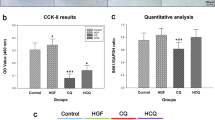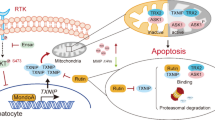Summary
Previous studies have shown that STAT3 plays a vital role in the genesis and progression of cancer. In this study, we investigated the relationship between the JAK2/STAT3 signalling pathway and germacrone-induced apoptosis in HepG2 cells. HepG2 cells were incubated with germacrone for 24 h, the protein expression of p-STAT3, STAT3, p-JAK2 and JAK2 was detected by Western Blotting, and RT-PCR was used to determine the expression of STAT3, p53, Bcl-2 and Bax at transcriptional levels. Besides that, HepG2 cells were pre-treated with AG490 or IL-6 for 2 h, and then incubated with germacrone for 24 h. The expression of p-JAK2, JAK2, p-STAT3, STAT3, p53, Bax and Bcl-2 was detected by Western blotting. The activity of HepG2 cells was tested by MTT assay. The apoptosis of HepG2 cells and levels of reactive oxygen species (ROS) were flow cytometrically measured. The results showed that germacrone exposure decreased p-STAT3 and p-JAK2 and regulated expression of p53 and Bcl-2 family members at the same time. Moreover, IL-6 enhanced the activation of the JAK2/STAT3 signalling pathway and therefore attenuated the germacrone-induced apoptosis. Suppression of JAK2/STAT3 signalling pathway by AG490, an inhibitor of JAK2, resulted in apoptosis and an increase in ROS in response to germacrone exposure. We therefore conclude that germacrone induces apoptosis through the JAK2/STAT3 signalling pathway.
Similar content being viewed by others
References
Dragani TA. Risk of HCC: genetic heterogeneity and complex genetics. J Hepatol, 2010,52(2):252–257
Giuliani J, Marzola M. Multidisciplinary approach as the key factor in the management of liver metastases from colorectal cancer. J Gastrointest Cancer, 2012:1–3
Chang ML, Lin SM, Yeh CT. HURP expression-assisted risk scores identify prognosis distinguishable subgroups in early stage liver cancer. Plos One, 2011,6(10):e26323
de Lope CR, Tremosini S, Forner A, et al. Management of HCC. J Hepatol, 2012,56Suppl 1:S75–87
Narimatsu S, Kariya S, Isozaki S, et al. Involvement of CYP2D6 in oxidative metabolism of cinnarizine and flunarizine in human liver microsomes. Biochem Biophys Res Commun, 1993,193(3):1262–1268
Robertson Remen KM, Gustafsson JA, Andersson G. The liver X receptor promotes macrophage differentiation and suppresses osteoclast formation in mouse RAW264.7 promyelocytic leukemia cells exposed to bacterial lipopolysaccharide. Biochem Biophys Res Commun, 2013, 430(1):375–380
Zhong Z, Chen X, Tan W, et al. Germacrone inhibits the proliferation of breast cancer cell lines by inducing cell cycle arrest and promoting apoptosis. Eur J Pharmacol, 2011,667(1–3):50–55
Deng C, Ji J, Li N, et al. Fast determination of curcumol, curdione and germacrone in three species of Curcuma rhizomes by microwave-assisted extraction followed by headspace solid-phase microextraction and gas chromatography-mass spectrometry. J Chromatogr A, 2006,1117(2):115–120
Liu Y, Wang W, Fang B, et al. Anti-tumor effect of germacrone on human hepatoma cell lines through inducing G2/M cell cycle arrest and promoting apoptosis. Eur J Pharmacol, 2013,698:95–102
Shu M, Zhou Y, Zhu W, et al. Activation of a pro-survival pathway IL-6/JAK2/STAT3 contributes to glial fibrillary acidic protein induction during the cholera toxin-induced differentiation of C6 malignant glioma cells. Mol Oncol, 2011,5(3):265–272
Hedvat M, Huszar D, Herrmann A, et al. The JAK2 inhibitor AZD1480 potently blocks Stat3 signaling and oncogenesis in solid tumors. Cancer Cell, 2009,16(6): 487–497
Yang J, Cai X, Lu W, et al. Evodiamine inhibits STAT3 signaling by inducing phosphatase shatterproof 1 in hepatocellular carcinoma cells. Cancer Lett, 2013,328(2): 243–251
Heo JY, Kim HJ, Kim SM, et al. Embelin suppresses STAT3 signaling, proliferation, and survival of multiple myeloma via the protein tyrosine phosphatase PTEN. Cancer Lett, 2011,308(1):71–80
Tsuyama N, Danjoh I, Otsuyama K, et al. IL-6-induced Bcl6 variant 2 supports IL-6-dependent myeloma cell proliferation and survival through STAT3. Biochem Biophys Res Commun, 2005,337(1):201–208
Li F, Fernandez PP, Rajendran P, et al. Diosgenin, a steroidal saponin, inhibits STAT3 signaling pathway leading to suppression of proliferation and chemosensitization of human hepatocellular carcinoma cells. Cancer Lett, 2010,292(2):197–207
Sen M, Joyce S, Panahandeh M, et al. Targeting Stat3 abrogates EGFR inhibitor resistance in cancer. Clin Cancer Res, 2012,18(18):4986–4996
Yen CY, Chiu CC, Haung RW, et al. Antiproliferative effects of goniothalamin on Ca9-22 oral cancer cells through apoptosis, DNA damage and ROS induction. Mutat Res, 2012,747(2):253–258
Kim J, Lee YJ, Shin DS, et al. Cosmomycin C inhibits signal transducer and activator of transcription 3 (STAT3) pathways in MDA-MB-468 breast cancer cell. Bioorg Med Chem, 2011,19(24):7582–7589
Barrero AF, Herrador MM, Quilez del Moral JF, et al. Efficient synthesis of the anticancer beta-elemene and other bioactive elemanes from sustainable germacrone. Org Biomol Chem, 2011,9(4):1118–1125
Yan J, Chen G, Tong S, et al. Preparative isolation and purification of germacrone and curdione from the essential oil of the rhizomes of Curcuma wenyujin by highspeed counter-current chromatography. J Chromatogr A, 2005,1070(1–2):207–210
Kuroyanagi M, Shirota O, Sekita S, et al. Transannular cyclization of (4S,5S)-germacrone-4,5-epoxide into guaiane and secoguaiane-type sesquiterpenes. Nat Prod Commun, 2012,7(4):441–446
Shen Y, La Perle KM, Levy DE, et al. Reduced STAT3 activity in mice mimics clinical disease syndromes. Biochem Biophys Res Commun, 2005,330(1):305–309
Negoro S, Kunisada K, Tone E, et al. Activation of JAK/STAT pathway transduces cytoprotective signal in rat acute myocardial infarction. Cardiovasc Res, 2000,47(4):797–805.
Tian Y, Zhang W, Xia D, et al. Postconditioning inhibits myocardial apoptosis during prolonged reperfusion via a JAK2-STAT3-Bcl-2 pathway. J Biomed Sci, 2011,18:53
Haga S, Terui K, Zhang HQ, et al. Stat3 protects against Fas-induced liver injury by redox-dependent and -independent mechanisms. J Clin Invest, 2003,112(7): 989–998
Niu G, Wright KL, Ma Y, et al. Role of Stat3 in regulating p53 expression and function. Mol Cell Biol, 2005,25(17): 7432–7440
Kusaba M, Nakao K, Goto T, et al. Abrogation of constitutive STAT3 activity sensitizes human hepatoma cells to TRAIL-mediated apoptosis. J Hepatol, 2007,47(4): 546–555
Sprinzl MF, Tappe D, Strand S, et al. Inhibition of JAK/STAT3 signalling leads to apoptosis of human hepatoma cells expressing a HCV replicon through ER stress-induced mechanisms. J Hepatol, 2005,42:167–168
Baba Y, Sonoda JI, Hayashi S, et al. Reduction of oxidative stress in liver cancer patients by oral green tea polyphenol tablets during hepatic arterial infusion chemotherapy. Exp Ther Med, 2012,4(3):452–458
Barry SP, Townsend PA, McCormick J, et al. STAT3 deletion sensitizes cells to oxidative stress. Biochem Biophys Res Commun, 2009,385(3):324–329
Author information
Authors and Affiliations
Corresponding authors
Additional information
These authors contributed equally to this work.
This project was supported by grants from the National Major Project of the People’s Republic of China (Nos. 2011ZX08002-004 and 2011ZX08010-004), the Wuhan Science and Technology Project (No. 201260523185) and the International Scientific and Technological Cooperation Project of Ministry of Science and Technology of China (No. 2009DFB20290).
Rights and permissions
About this article
Cite this article
Liu, Yy., Zheng, Q., Fang, B. et al. Germacrone induces apoptosis in human hepatoma HepG2 cells through inhibition of the JAK2/STAT3 signalling pathway. J. Huazhong Univ. Sci. Technol. [Med. Sci.] 33, 339–345 (2013). https://doi.org/10.1007/s11596-013-1121-z
Received:
Published:
Issue Date:
DOI: https://doi.org/10.1007/s11596-013-1121-z




